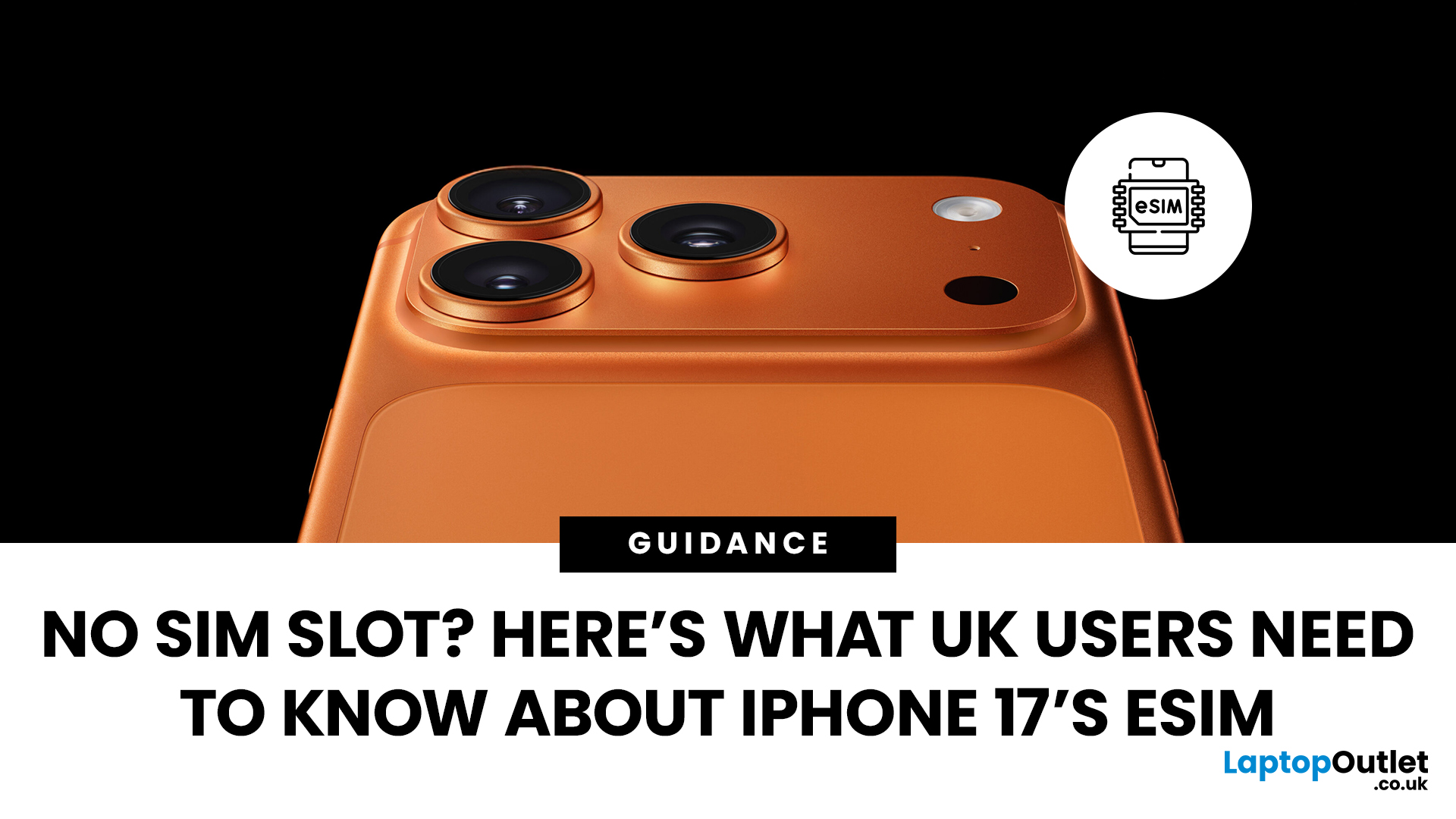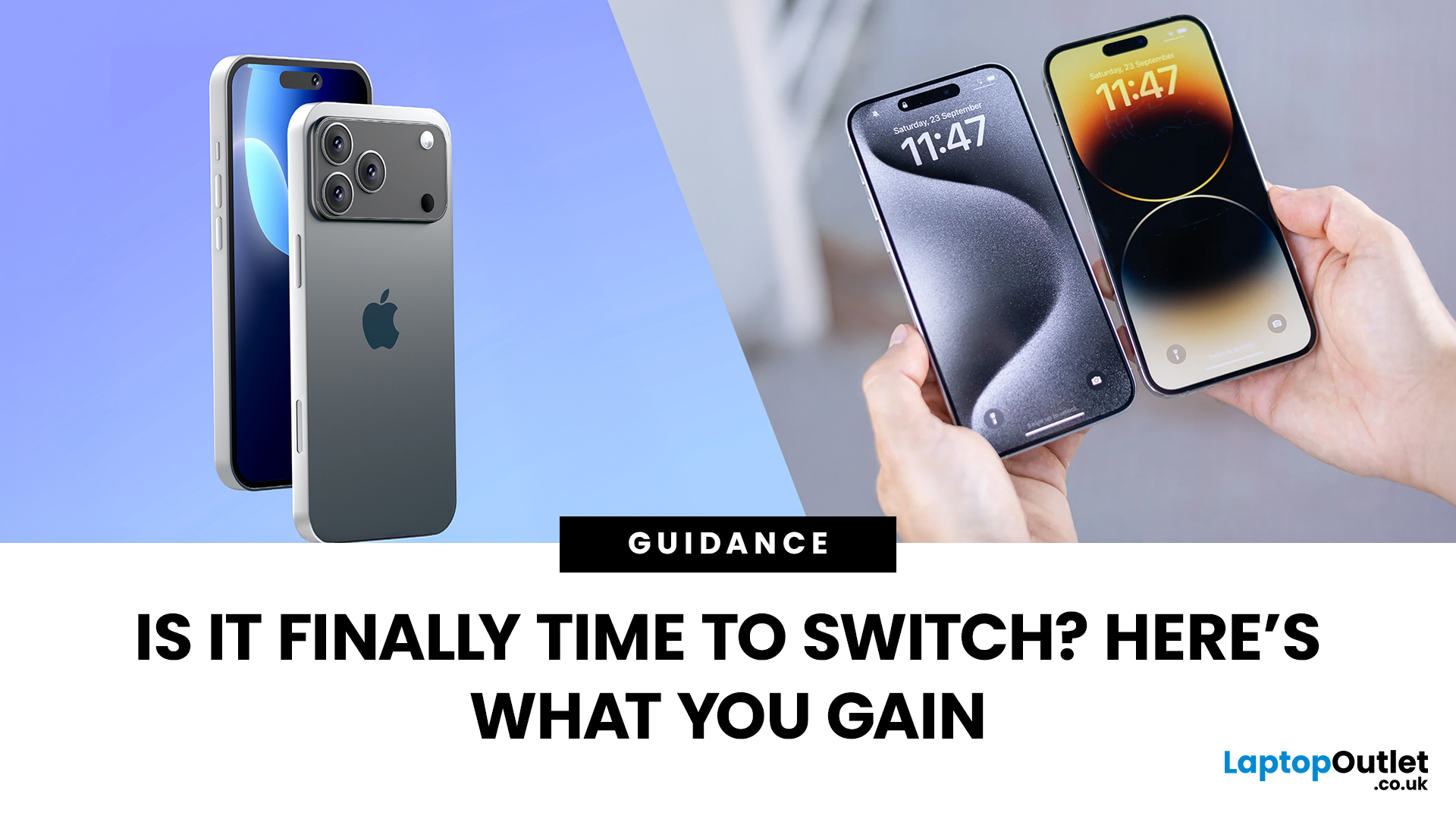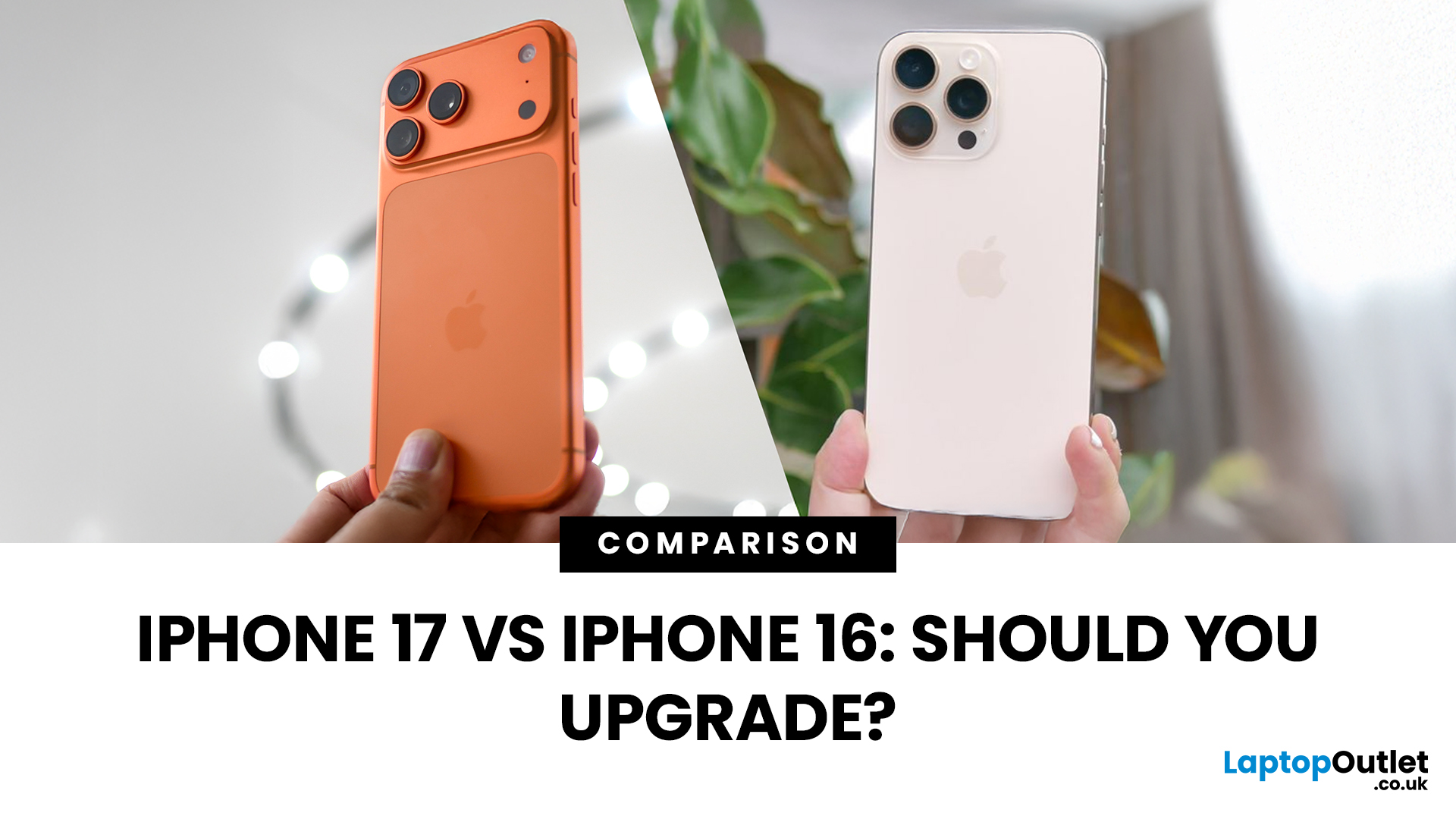No SIM Slot? Here’s What UK Users Need to Know About iPhone 17’s eSIM

Every new iPhone generation brings changes that divide opinion, and one of the biggest talking points around the iPhone 17 has been its SIM setup. In the US, Apple has already removed the SIM tray entirely, pushing users towards a digital-only future with eSIM. That led many UK customers to wonder: will we lose our SIM cards too?
The answer, at least for now, is no. According to Apple’s own specifications, the iPhone 17 sold in the UK still supports Dual SIM (nano-SIM and eSIM) as well as Dual eSIM. In simple terms, that means users can continue using a traditional SIM card while also taking advantage of the flexibility eSIM brings.
What Exactly is eSIM?
An eSIM is a digital version of the small plastic SIM card we’ve all been sliding into our phones for years. Instead of a physical chip, the details of your mobile plan are stored electronically within your iPhone. Activation is usually as simple as scanning a QR code from your network or confirming details in their app.
The main appeal is convenience: switching networks or adding a new number no longer requires waiting for the postman or hunting down a SIM ejector tool. For those who travel frequently, an eSIM also makes it easier to load a local data plan abroad without juggling tiny cards.
How iPhone 17 Handles SIMs in the UK
For UK customers, the iPhone 17 offers a kind of middle ground. You can still insert a physical nano-SIM, which will reassure anyone nervous about going fully digital. But you also have the option of running two eSIMs at the same time, or pairing one eSIM with a traditional SIM.
This flexibility means the transition won’t feel forced. If your network already supports eSIM — and most of the major UK carriers do — you can give it a try. If you’d rather stick with your tried-and-tested plastic SIM for now, you can do that too.
Why Apple is Pushing eSIM
Apple has a track record of phasing out older technologies once it believes the world is ready. The headphone jack and the home button were controversial losses at the time, but today they’re barely missed. eSIM looks set to follow the same path.
From Apple’s perspective, removing the SIM tray means one less moving part, better water resistance, and more space inside for things like larger batteries or slimmer designs. For users, it promises smoother switching between providers and easier management of multiple numbers.
The UK Network Picture
The good news is that Britain is well positioned for this shift. EE, O2, Vodafone, and Three all support eSIM, as do many smaller networks. Activating one can usually be done through a QR code, an app, or a quick call to customer service.
Where things get patchy is with certain pay-as-you-go deals or smaller providers, which may still be catching up. If you’re considering an iPhone 17 and want to use eSIM, it’s worth checking whether your chosen plan is compatible.
Travel and Roaming with eSIM
One of the biggest advantages for UK travellers is the ability to set up a local data plan abroad before you even leave home. Services like Airalo or Holafly let you download a temporary eSIM for destinations ranging from Spain to Singapore in just a few taps.
That said, not every country has embraced eSIM yet. In some places, picking up a cheap local SIM card is still the norm, which is why it’s reassuring that the UK iPhone 17 models retain a physical slot. You’ll have both options in your pocket.
Security and Practicalities
eSIM also brings subtle security benefits. Because there’s no card to remove, thieves can’t simply swap your SIM into another device. Your number is tied more closely to your account and your phone, which reduces certain types of fraud.
The only extra step to remember is that if you’re selling or passing on your iPhone, you’ll need to deactivate your eSIM profile rather than just pulling out a card. It’s simple enough, but worth noting.
Should You Be Concerned?
For UK users, there’s little to worry about. The iPhone 17 gives you the best of both worlds: the familiarity of a nano-SIM alongside the modern convenience of eSIM. Apple may well remove the slot entirely in future generations, but the fact that iPhone 17 keeps it shows that the transition is being handled gradually.
If you’re curious, this could be the perfect time to experiment with eSIM while still keeping your physical SIM as a safety net. For most people, the change will feel less like a shock and more like a gentle nudge towards the future.

Final Word
The move to eSIM is inevitable, and the iPhone 17 makes it clear that Apple is steering users in that direction. But here in the UK, you won’t lose the ability to use a traditional SIM just yet. Instead, you get flexibility: stick with what you know, or explore the benefits of going fully digital.
Either way, the days of fiddling with tiny plastic cards are numbered — and with the iPhone 17, you’ve got the choice of when to let them go.

Frequently Asked Questions
1. Does the iPhone 17 have a SIM slot in the UK?
Yes. The iPhone 17 models sold in the UK support Dual SIM (nano-SIM and eSIM). This means you can still use a physical SIM card alongside an eSIM.
2. Can I use two eSIMs on the iPhone 17?
Yes. The iPhone 17 supports Dual eSIM, which allows you to run two digital SIM profiles at the same time without needing a physical card.
3. Which UK networks support eSIM on iPhone 17?
Major providers including EE, O2, Vodafone, and Three already support eSIM on a wide range of plans. Some smaller networks and MVNOs (like Lyca Mobile, Sky Mobile, and Giffgaff) also offer eSIM, though availability may vary.
4. Is it easy to switch from a physical SIM to an eSIM on iPhone 17?
Yes. Most UK networks let you request an eSIM via their app, in-store, or through customer support. Activation usually involves scanning a QR code or entering details in your iPhone’s settings.
5. Will UK travellers face problems using eSIM abroad?
Not usually. Many countries now support eSIM, and you can even buy international eSIM plans through apps like Airalo or Holafly before travelling. However, in some regions where eSIM adoption is limited, you may still rely on a physical SIM — which your iPhone 17 supports.
| Read More: |
| Should You Upgrade to iPhone 17 from iPhone 14 or 15? |
| iPhone 17 vs Samsung Galaxy S25: Which Flagship Wins |
| New iPhone 17 Design: Horizontal Camera Bar & Bold Colours Revealed |
Related Articles

September 15, 2025
The wait is over – the iPhone 17 has officially arrived, bringing Apple’s biggest year-on-year changes since the iPhone X. With a slimmer design, brighter ProMotion display, more powerful A19 chip, and camera improvements across the board, the question on every Apple fan’s mind is simple: should you upgrade to iPhone 17 if you already own the iPhone 14 or 15? Let’s break it down.
What’s New with the iPhone 17
Apple has positioned the iPhone 17 as its most refined all-rounder yet. Here’s what you’ll notice immediately:
- Sleeker design: The iPhone 17 is slimmer and lighter, with refined aluminium edges and new colours to choose from.
- ProMotion for all: For the first time, every model in the lineup, not just the Pros, comes with a buttery-smooth 120 Hz display. Scrolling, gaming, and everyday navigation feel instantly more fluid.
- A19 processor: Apple’s latest chip brings faster performance, but more importantly, greater energy efficiency. Multitasking and gaming are snappier, while battery

September 15, 2025
Apple’s iPhone 17 lineup arrives with some of its most substantial camera upgrades in years. For photography lovers and content creators, the shift to 48MP sensors across more lenses, plus a jump in optical zoom for the Pro models, represents key changes. But how much difference will these make in everyday use? Below, we break down what’s new in the iPhone 17 camera, what’s exciting, and what you should know before upgrading.
What’s New: Key Hardware Upgrades
1. 48MP Sensors Across the Board (Pro & Standard Models)
Traditionally, Apple used 48MP for its main wide lens on Pro models, with ultra-wide and telephoto lenses at lower resolutions. In iPhone 17 Pro and Pro Max, all three rear lenses are upgraded to 48MP each.
For the standard iPhone 17, Apple is using a “Dual Fusion” 48MP setup (main + ultra-wide lenses), meaning better detail even from non-Pro models.
2. Big Leap in Optical Zoom: Up to 8× on Pro Max
The Pro Max model is getting what many considered long overdue: an 8× optical

September 15, 2025
Apple’s 2025 refresh changes the line-up. Alongside the familiar iPhone 17, 17 Pro and 17 Pro Max. Headline upgrades include 120 Hz ProMotion across the board, bigger displays for the standard model, a new 18 MP selfie camera with Centre Stage, and next-gen A19 chips (A19 in iPhone 17; A19 Pro in Pro/Pro Max). The iPhone 16 family is still excellent, especially 16 Pro/Pro Max, but how do they stack up now, and should you upgrade? Let’s compare the essentials for UK buyers.
iPhone 17 vs iPhone 16
Specs below focus on the standard models (17 vs 16) for clarity, with Pro notes called out where relevant.
|
Feature |
iPhone 17 (2025) |
iPhone 16 (2024) |
|
Display |
6.3" OLED, 120 Hz ProMotion, always-on, higher peak brightness |
6.1" OLED, 60 Hz, always-on on Pro models only |
|
Chip |
A19 (A19 Pro on Pro/Pro Max) |
A18 (A18 Pro on 16 Pro/Pro Max) |
|
Rear cameras |
48 MP main + 48 MP ultra-wide (Pro adds 48 MP tele) |
48 MP main + 12 MP ultra-wide (Pro adds tele) |
|
Front camera |
18 MP with Centre Stage (all models) |
12 MP |

September 15, 2025
Apple’s iPhone 17 series has just dropped, and UK buyers are asking: What’s the cost? What deal should I get? And how soon can I pre-order? This guide walks through the confirmed pricing, expected contract deals, trade-in options, and pre-order details so you can plan your upgrade smartly.
1. Confirmed UK Prices Outright
Here are the UK “SIM-free” or outright purchase prices as reported by multiple UK sources:
|
Model |
Starting Price (UK) |
|
iPhone 17 (base) |
~ £799 |
|
iPhone 17 Air |
~ £949 |
|
iPhone 17 Pro |
~ £1,199 |
|
iPhone 17 Pro Max (256 GB) |
~ £1,199 |
|
iPhone 17 Pro Max (highest trim, 2 TB) |
~ £1,999 |
Note: These are base model price points; storage upgrades increase the cost. Also, there is a notion that many iPhone models might be ~£50 more expensive at launch than last year’s equivalents.
2. Pre-Order & Release Dates
- Announcement: iPhone 17 lineup unveiled on 9 September 2025.
- Pre-orders begin: Friday, 12 September at ~1 pm BST in the UK.
- General UK release date: Friday, 19 September 2025.
